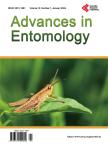<i>Anopheles leesoni</i>Evans 1931, a Member of the <i>Anopheles funestus</i>Group, Is a Potential Malaria Vector in Cameroon
<i>Anopheles leesoni</i>Evans 1931, a Member of the <i>Anopheles funestus</i>Group, Is a Potential Malaria Vector in Cameroon作者机构:Malaria ResearchLaboratory Organisation de Coordination pour la lutte Contre les Endémies en Afrique Centrale (OCEAC) Yaoundé Cameroun Faculty of Sciences University of Yaoundé I Yaoundé Cameroon Faculty of Medicine and Pharmaceutical Sciences University of Douala Douala Cameroon Centre for Research in Infectious Diseases Yaoundé Cameroon Department of Vector Biology Liverpool School of Tropical medicine Liverpool L3 5QA UK Vector Borne Infectious Disease Unit of the Laboratory of Applied Biology and Ecology (VBID-LABEA) Department of Animal Biology Faculty of Science University of Dschang Dschang Cameroon
出 版 物:《Advances in Entomology》 (昆虫学(英文))
年 卷 期:2022年第10卷第1期
页 面:99-109页
学科分类:07[理学] 0701[理学-数学] 070101[理学-基础数学]
主 题:Anopheles funestus Group Anopheles leesoni Plasmodium falciparum Malaria Transmission Cameroon
摘 要:Background: Understanding the biology of Anopheles malaria vector species is essential to planning effective and sustainable malaria control strategies in endemic countries. This study reported the implication of Anopheles leesoni in malaria transmission in Cameroon, Central Africa. Methods: Mosquitoes were collected in three localities from May 2015 to March 2018 using electric aspirators and Centers for Disease Control light traps (CDC-LT). Anopheles funestus sensu lato (s.l.) mosquitoes were identified as species using polymerase chain reaction assay (PCR). Furthermore, Plasmodium falciparum infection status was determined using the enzyme-linkedimmunosorbent assay (ELISA) method. Results: A total of 12,744 Anopheles mosquitoes were collected by electric aspirator (N = 4844) and CDC-LT (N = 7900). span s



